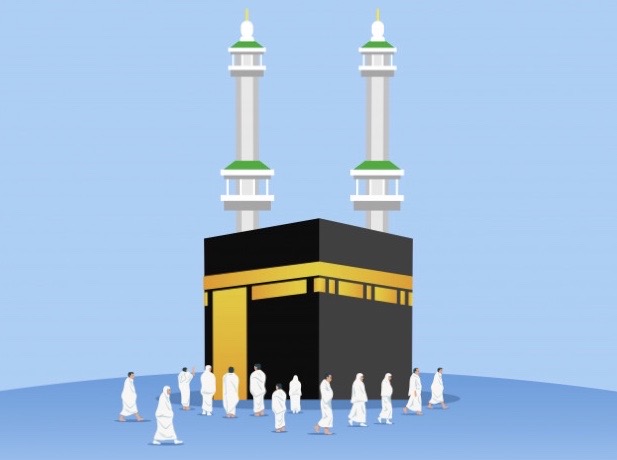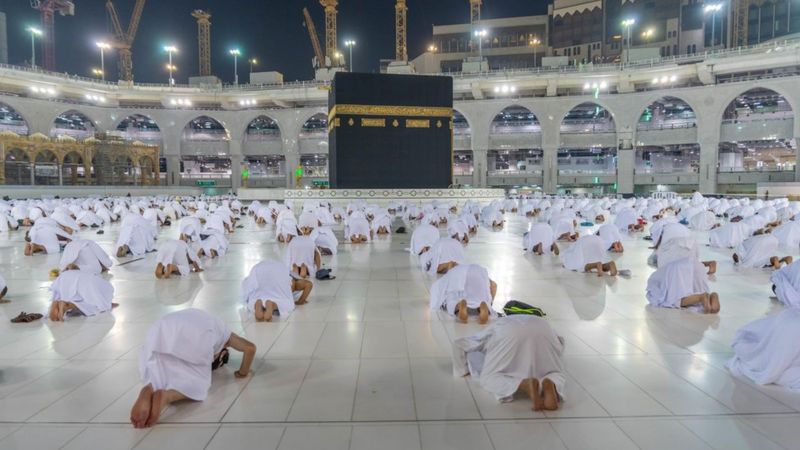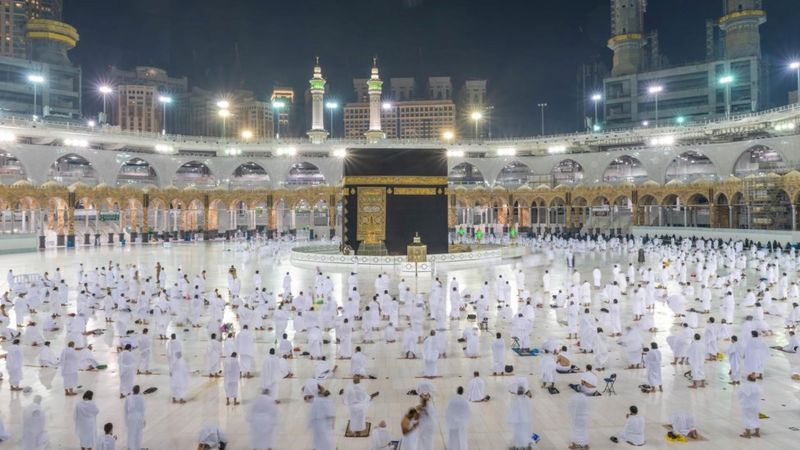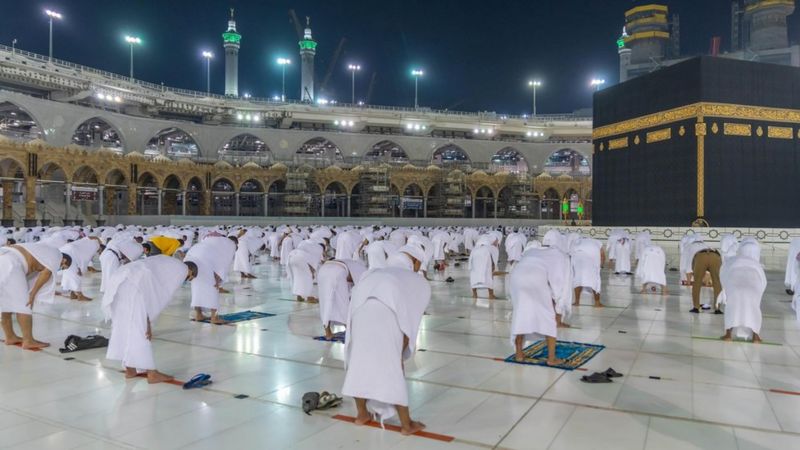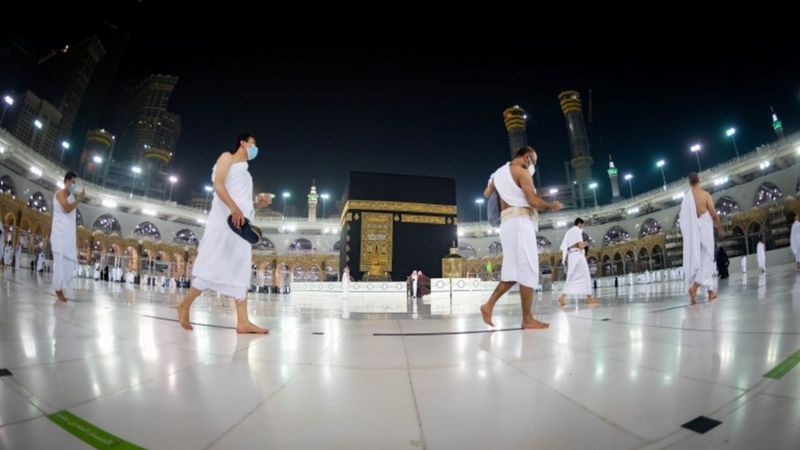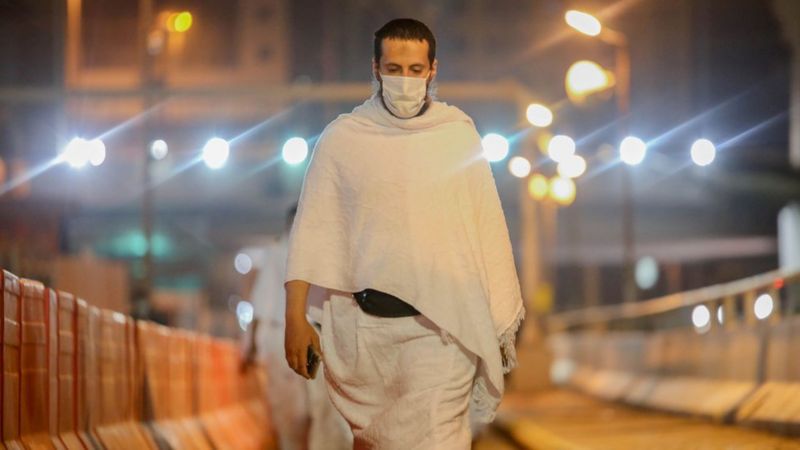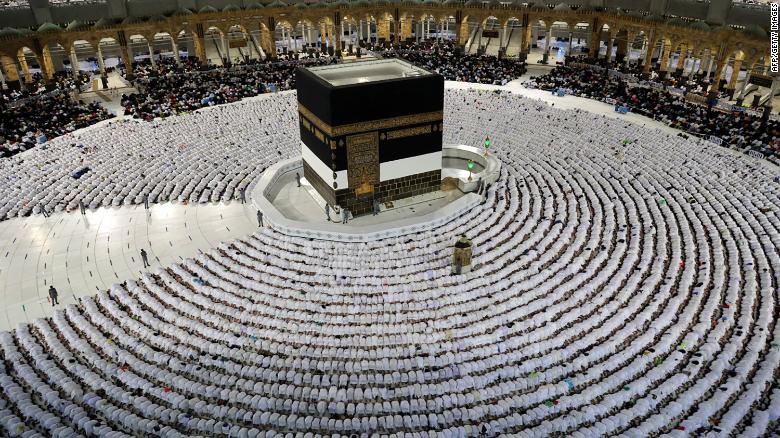“The halls felt like they were on fire,” one Jordanian woman said of her accommodations after she opted to take a cheaper travel package for “unregistered” pilgrims to Saudi Arabia.

Muslims performing the Eid al-Adha morning prayer around the Kaaba, Islam’s holiest shrine, at the Grand Mosque in Mecca on June 16, marking the end of the hajj pilgrimage.Credit...Agence France-Presse — Getty Images
Huda Omari sat outside a broker’s office in Jordan for two days, waiting for her visa to make the annual hajj, or pilgrimage, to Saudi Arabia.
In Egypt, Magda Moussa’s three sons pooled their resources to scrape together nearly $9,000 to realize a dream of accompanying their mother to the hajj. When she got the go-ahead for the trip, she said, relatives and neighbors in her village ululated in celebration.
The dayslong pilgrimage is a profound spiritual journey and an arduous trek under the best of circumstances. But this year, amid record heat, at least 1,300 pilgrims did not survive the hajj, and Saudi authorities said that more than 80 percent of the dead were pilgrims who lacked permits.
Ms. Omari and Ms. Moussa were among a large number of unregistered pilgrims relying on illicit or fraudulent tour operators to skirt the official permit process. Both said they were aware that the once-in-a-lifetime trip would be physically and financially demanding, but neither foresaw the terrible heat or mistreatment they would endure.
“We were humiliated and punished for being there illegally,” Ms. Omari, 51, told The New York Times after returning home.
With nearly two million people participating each year, it is not unusual for pilgrims to die from heat stress, illness or chronic disease during the hajj. And it is unclear whether this year’s toll was higher than usual because Saudi Arabia does not regularly report the numbers. Last year, 774 pilgrims died from Indonesia alone, and in 1985 more than 1,700 people died around the holy sites, most of them from heat stress, a study at the time found.
But this year’s deaths drew attention to the disturbing underbelly of an industry that profits from pilgrims who often spend years saving to complete one of Islam’s most important rites.
ImageA person with an umbrella walks through a crowd of people in a city on a sunny day.

Muslim pilgrims arriving in Mecca on June 11 before the annual pilgrimage.Credit...Fadel Senna/Agence France-Presse — Getty Images
To control the influx of visitors and avoid tragedies like the 2015 stampede, the Saudi government has sought to register pilgrims. Those who are registered must buy a government-sanctioned travel package that has become too expensive for many.
Those who enter on other types of visitors’ visas have difficulty accessing the safety measures put in place by the authorities. So pilgrims’ financial means determined the conditions and treatment they experienced, including their protection from — or exposure to — the Gulf’s increasingly dangerous and extreme heat.
Registered pilgrims stay in hotels in the holy city of Mecca or in Mina, a city of white tents that can house up to three million and which offers showers, kitchens and air-conditioning. They are also transported between holy sites, sparing them from the hot sun.
The map highlights the city of Mecca in western Saudi Arabia, and the city of Mina, just east of Mecca. Mount Arafat, southeast of Mina is also indicated. It also locates the port city of Jeddah on the Red Sea. The city of Bahadah, near Cairo in Egypt, and Amman, the capital of Jordan, are also located.
SAUDI ARABIA
Red Sea
Jeddah
Mina
Mecca
MOUNT
ARAFAT
Amman
IRAN
JORDAN
Bahadah
SAUDI
ARABIA
EGYPT
Detail
area
30 MILES
400 MILES
By The New York Times
The unregistered in Mecca found themselves stuffed in bare apartments in a southern district that has become popular with the travel brokers who cater to them, according to some of those who went. During the months surrounding the rite, these brokers rent out entire buildings and pack them with pilgrims.
Still, many are undeterred. And as pilgrims return to their home countries, a clearer picture is emerging of the conditions they endured.
Image
One person sits beside a suitcase as another person stands nearby at a brick wall.

Pilgrims in Mecca last month.Credit...Abdel Ghani Bashir/Agence France-Presse — Getty Images
Working with the Saudi authorities, Jordan has limited the number of people allowed to participate in the hajj annually. And the Jordanian authorities said last week they had arrested 54 people and shuttered three travel agencies after 99 Jordanians died during the hajj.
Ms. Omari lives in Irbid, Jordan’s second largest city, where she said she sells spices to make extra money. She scraped together 140 Jordanian dinar, nearly $200, for a visa that allows Muslims to visit Saudi holy sites but excludes them from the hajj.
In all, Ms. Omari paid 2,000 dinars (more than $2,800) for a package that included travel, insurance and accommodations. Though it was “no small amount,” she said, it was still just half of the cost of the official hajj package.
Egypt, where rising inflation and a weakened currency have put the pilgrimage out of reach for many, may have had one of the highest number of fatalities this year, but the authorities there have not confirmed the toll. Egyptian officials have recently closed 16 tour operators, and arrested and charged two travel brokers.
Magda Moussa’s three sons had long dreamed of taking her to the hajj, and this was the year that dream would be realized. It would cost them 120,000 Egyptian pounds (nearly $2,500) for her trip alone, and they would accompany her at 100,000 Egyptian pounds each. Still, the cost was substantially less than the official package.
When Ms. Moussa, a widowed grandmother who used to work as a telecoms technician, received her visa, her family and neighbors in the village of Bahadah, near the capital Cairo, celebrated her good fortune.
Image
Magda Moussa looks into the distance inside her home.

Magda Moussa, 63, at home in her village in Egypt last month.Credit...Fatma Fahmy for The New York Times
The hajj is one of the five pillars of Islam, dating back centuries to when pilgrims first walked in the footsteps of the prophets. All Muslims who are physically and financially able are obliged to perform it at least once.
Today, there are tiered visitors’ packages for the registered and a widening gap between those who can afford these packages and the unregistered who cannot.
When Ms. Omari arrived, she said, she was assigned a room in a building where the air-conditioning barely worked.
“The halls felt like they were on fire,” she said.
So she shelled out more money for a decent hotel, where she shared a room with women from her hometown.
Ms. Moussa was luckier: Her sons paid hundreds of dollars for her to have a bed in a hotel room with three other women, while the sons spent more than $200 to sleep on a mattress on the floor in another building, in a room crowded with eight men.
Image
Crowds of people pack into wide walled-off streets that wind through a cityscape.

Pilgrims arriving to perform the symbolic “stoning of the devil” ritual as part of the hajj in Mina on June 16.Credit...Fadel Senna/Agence France-Presse — Getty Images
Saudi officials removed at least 300,000 unregistered pilgrims from Mecca even before the hajj began, sending many of those without proper documentation to the port city of Jeddah, more than 40 miles away, according to Saudi state media. Others were deported.
As the hajj drew closer, police raids intensified, witnesses said.
“We are pilgrims. We are Muslims,” said Ms. Omari. “We are not here to cause problems.”
Panicking brokers fearing arrest cut off electricity or disconnected internet service in some buildings to make them appear unoccupied, witnesses said. Some even chained the gates to the buildings to keep pilgrims in and the police out.
“Often we felt imprisoned,” said Ahmed Mamdouh Massoud, one of Ms. Moussa’s sons. He had traveled as an unregistered pilgrim before, he said. But this year, he felt very unwelcome.
“I never saw anything as bad as this time,” he said, describing the heavy police presence, dozens of check points and random checks.
Ms. Moussa said her family had lived off canned food that they brought from Egypt during the hajj and, out of fear, ventured outside only to buy yogurt and dates in Mecca.
Ms. Omari, who arrived nearly a month before the hajj began in mid-June, remained holed up in the room she shared with four other women, leaving only to perform religious rites.
“We know we only go once in our lifetime, and this was it,” she said.
On the eve of the Day of Arafat — the day when pilgrims gather near Mount Arafat as one of the hajj rituals — no car or bus would pick her up because she did not have the right permit, Ms. Omari said. So she walked 12 miles to reach the plain of Arafat under a scorching sun with choking humidity. Temperatures surpassed 120 degrees during the hajj period.
“It was like fire from the sky and under your feet,” she said.
Image
Magda Mousa, wearing a backpack on her front, raises her arms while standing among numerous other pilgrims.

A picture of Magda Mousa in Arafat taken by her son Ahmed Masoud.
Ms. Moussa said she had tried to board a bus, but a Saudi police officer demanded hajj permits from her and the women she was with. The officer threatened to end their pilgrimage, so close to its zenith, if they could not produce permits.
“After all those years wishing for this day, now they want to prevent us?” she said.
Ms. Moussa, stung by the treatment, said she quietly exited the bus through the back door. She bundled her belongings and balanced them on her head, and then began walking. Stopping only to pray or ask for directions, she walked through the night.
“I had plastic slippers on,” she said. “By the time I arrived, they had gotten so worn-out, they felt as if I was wearing nothing on my feet.”
As she walked, she said, pilgrims in air-conditioned buses gawked at her as she limped along the path. Someone took a video of her that went viral in Egypt.
The two women’s families reached the plain of Arafat, but the walk back exposed the tragedy of the situation.
“Younger people than me were lying dead,” Ms. Moussa said. “It was heartbreaking.”
Image
A person in uniform attends to a person lying on the ground as others sit or walk nearby.

A man affected by the scorching heat is helped by a member of the Saudi security forces in Mina on June 16.Credit...Fadel Senna/Agence France-Presse — Getty Images
https://www.nytimes.com/2024/07/08/worl ... eaths.html